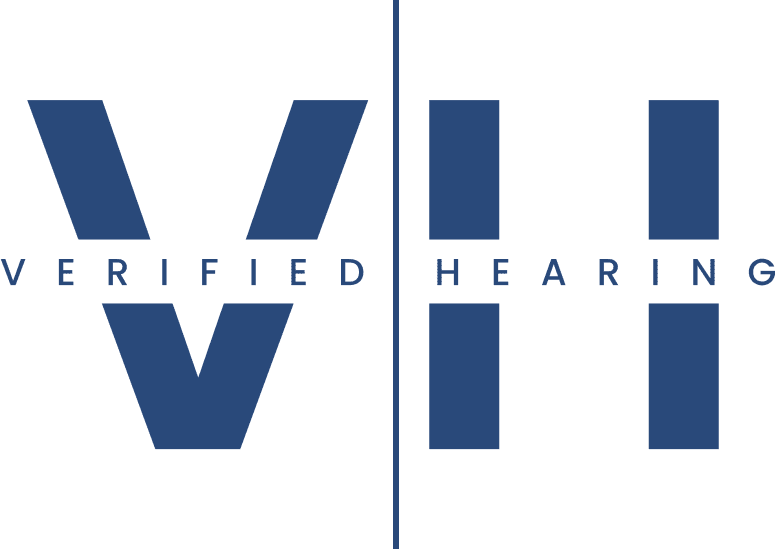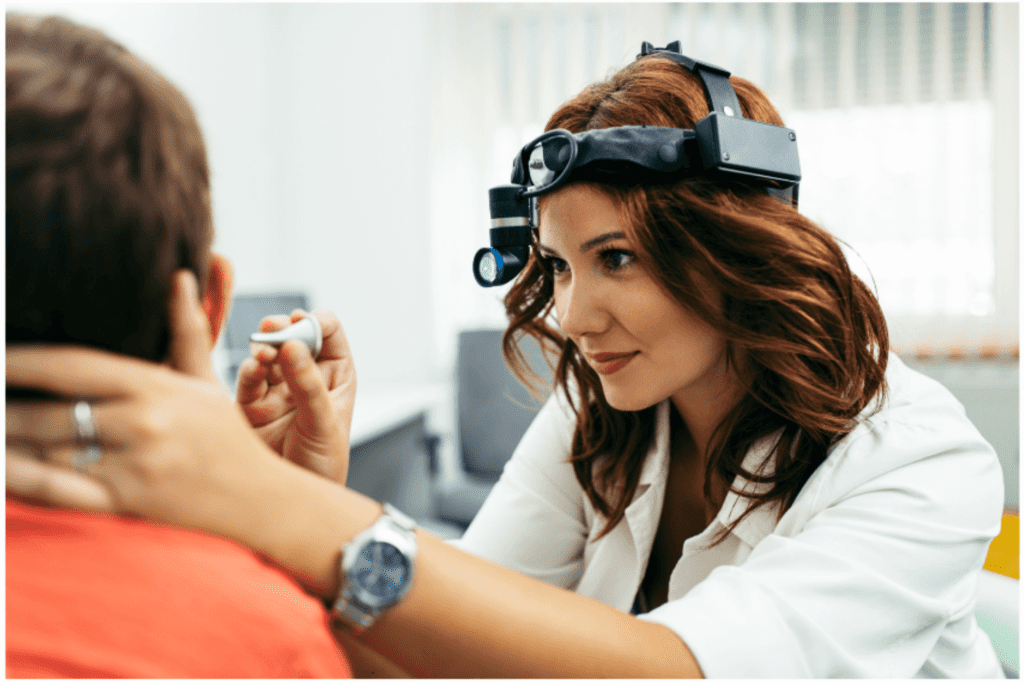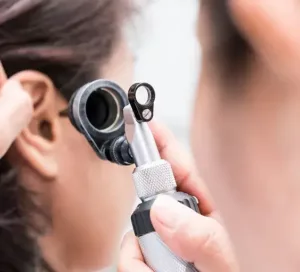Ear wax: What is it?
Earwax, medically known as cerumen, is a natural acidic substance produced by glands in the skin of the outer ear canal to lubricate, protect and clean the ear.
Earwax acts as a natural barrier, preventing dirt, bacteria, and other foreign particles from entering the inner ear. Without earwax, the outer ear might become dry, itchy, and more susceptible to infections.
Our ears are self-cleaning. The skin of the ear canal has a special ability to move, somewhat like a conveyor belt. New skin cells are produced in the outer part of the ear canal, and older skin cells are pushed towards the outer opening of the ear. This movement is aided by the movements of the jaw (e.g., when we talk or chew). However, sometimes ear wax builds up over time and can cause unpleasant symptoms.
Need ear wax removal

Ear wax buildup
Video from Verified Hearing
What causes ear wax buildup?
Earwax buildup can be caused by a variety of factors, including the anatomy of your ear canal, age (as the consistency of earwax changes with age), use of hearing aids, airpods or earplugs, or even habits like using cotton swabs which can push the wax further into the ear. In our experience, individuals with skin conditions like psoriasis can also suffer from more frequent wax and dead skin buildup in the ear canal.
Earwax buildup symptoms
You may have ear wax if you are experiencing one or more of the following symptoms:
Hearing loss (muffled hearing, blocked ear [not always wax]): Ear wax build-up can create a barrier, diminishing the transmission of sound waves, resulting in reduced or muffled hearing. It is always important to have your ear checked by an ear professional as soon as your symptoms start as not all ear blockages or sudden hearing losses are caused by ear wax. In some rare instances, we find patients could be suffering from a sudden sensorineural hearing loss (SSHL). The treatment for SSHL is time sensitive (a higher chance of your hearing recovering in the first 72 hours) but the symptoms can present in a similar way to wax build-up.
Vertigo (balance problems, dizziness, light-headedness)
Ear pain: Impacted wax can exert pressure on the ear canal or eardrum, causing discomfort or a painful sensation.
Tinnitus (Pulsatile tinnitus, ringing, whooshing): Excessive wax can interfere with the ear's normal operations, producing internal noises or exacerbating existing tinnitus.
Headaches: The pressure from impacted wax can stimulate nerve endings, potentially leading to referred pain experienced as headaches.
Jaw Pain: The ear canal's proximity to the temporomandibular joint (TMJ) means pressure from wax can manifest as jaw discomfort.
Anxiety: The disorienting effects of hearing loss, tinnitus, or vertigo can trigger or amplify feelings of anxiety in individuals.
Nausea: Vertigo, resulting from wax build-up, can upset the inner ear's balance mechanism, leading to feelings of nausea.
Pressure in head: Impacted wax can create a sense of fullness or pressure in the ear, which some might describe as head pressure.
Ear popping: Accumulated wax can hinder the eustachian tube's function, causing irregular pressure changes felt as ear popping.
Speech delay in Children: Persistent hearing loss due to wax accumulation in children can impact their auditory learning, potentially causing speech development delays.
Experiencing ear wax build-up symptoms?
Book a same-day ear wax removal service

Preventing ear wax buildup
After suffering from the discomfort clogged ears can cause, it is common to want to find a way to prevent it from happening again. Unfortunately, there is no magic pill that can stop earwax buildup as it is a natural process. However, you can ensure your ear wax does not become impacted by attending a regular ear check-up, not using cotton buds to clean your ears, and if you are particularly susceptible to wax buildup, maybe think of using over the ear headphones as opposed to airpods. Sleeping ear plugs can also cause earwax to become impacted over time.
Quick tips for earwax buildup
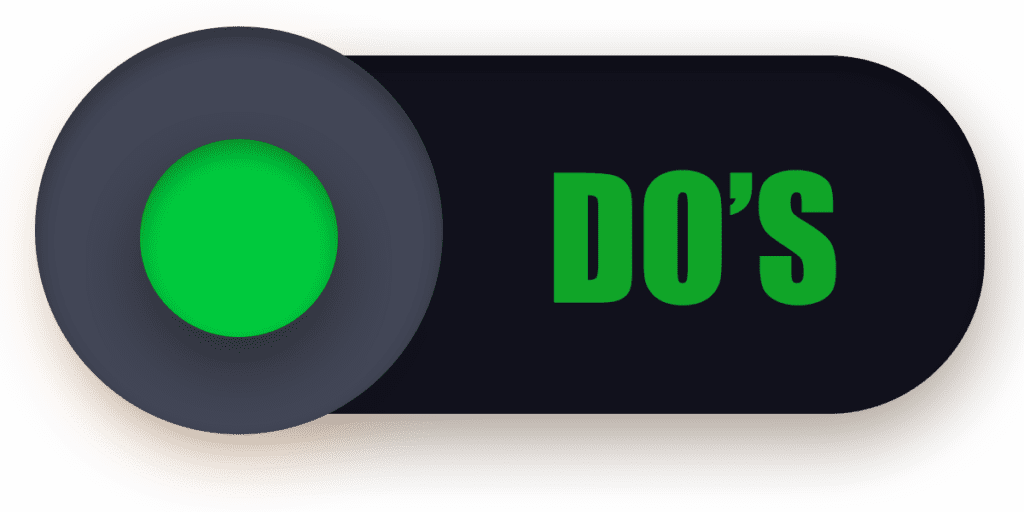
Get some olive oil ear drops (we recommended earol) follow our olive oil drops guide to apply at least 2-3 days before your professional ear cleaning appointment.
Type “ear wax removal near me” into google and I can guarantee you will see a professional ear wax removal place not too far.
Check to make sure the ear wax removal professional is an audiologist, ENT, or nurse with the relevant qualifications and training to remove your ear wax safely. Read the reviews, it's usually a good telling sign.
Make sure the professional you go to has the facility to investigate the cause of your ear blockage if it is not ear wax. You can usually ask before you book or check their website for this information.
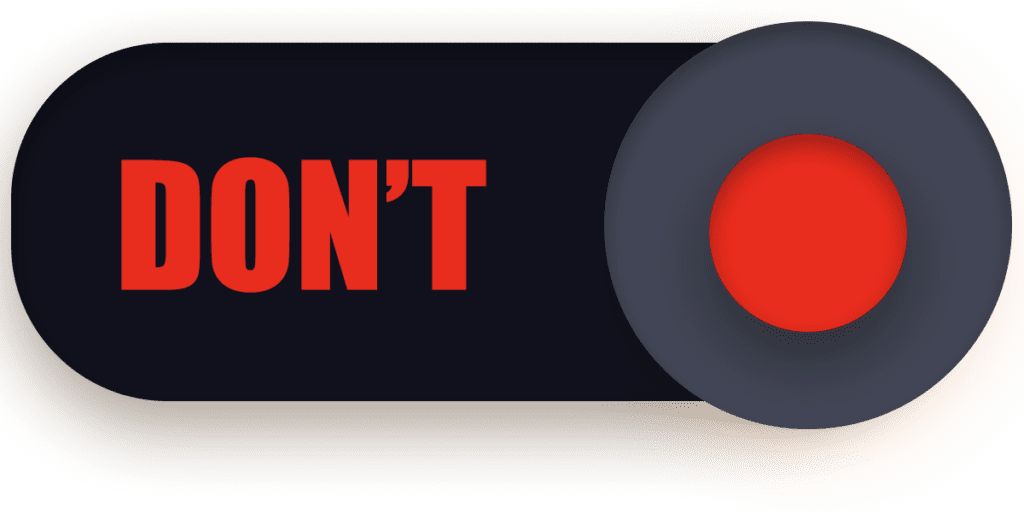
Don’t use cotton buds
Do not try to wash your ears with warm water under a shower. It does not work and it will make it worse.
Do not try to use ear candles or any other at-home remedies you see online. The chances are you may cause an injury to your ear canal, perforate your eardrum, or make the situation generally worse.
Don’t ask your partner to try to use q-grips to remove the wax with their phone touch.
Don’t panic. If you have applied the olive oil drops correctly your ears will feel more blocked because the ear wax has been softened and expanded in your ear canal. This is a good sign - it means you are ready to have your wax professionally removed.
Types of ear wax
Ear wax has two simple classifications based on its consistency. It’s either hard or soft.
Video from Verified Hearing
Hard Earwax: hard ear wax is stone-like in consistency. The issue with this kind of ear wax is that it can become painful, especially if it presses against the eardrum or occludes the ear canal. Your audiologist will be able to tell you if you have hard ear wax or not. In such cases, using sodium bi-carbonate drops for a few days before your ear wax removal appointment can be helpful.
Video from Verified Hearing
Soft Earwax: soft ear wax is sticky and may be yellowish or brownish in colour. While soft earwax is less likely to cause pain, excessive production can still lead to impaction which can cause temporary hearing loss and a feeling of pressure in your ears. Use olive oil drops 3-5 days before your ear cleaning appointment if you have soft ear wax.
Video from Verified Hearing
Avoiding at-home ear cleaning: The ear canals of children are delicate. Cotton swabs can push wax deeper, causing impactions. They might also risk injuring the eardrum. Do not use any irrigation kit even if you can get these from the pharmacy.
Impacted Earwax: Hard or soft earwax can become impacted when it is pushed deeper into the ear canal, often due to activities like using cotton buds. Your ear canal has two parts. The outer one-third has cartilage underneath the skin (less sensitive) while the inner two third has bone underneath the skin (very sensitive). Wax forms in the outer part of the ear canal and it can cause significant discomfort when pushed to the inner part of the ear canal. From time to time, dead skin migration occurs, moving from the eardrum out like a conveyor belt. In theory, this process should push the wax out your ear canals. However, using Q-tips for ear cleaning and consistent use of ear buds can stop this natural ear cleaning process from happening thereby causing impacted ear wax. This is also why hearing users experience more earwax buildup.
Suffering from impacted ear wax?

Ear wax colours and meaning
The colour and consistency of ear wax can actually provide subtle hints about your ear health and, in some cases, about general health conditions. Let’s explore the various shades of ear wax and decipher their meanings:
Light Yellow to Dark Yellow: This is the most common colour and is typically seen in children and young adults. It indicates that the glands in your ears are producing cerumen to trap dirt and ensure no harm befalls the eardrums.
Dark Brown to Black: As ear wax ages and mixes with dirt, it tends to darken. Dark brown to black ear wax can be an indication that the wax is hard and it’s been in the ear for a longer period of time
White and Flaky: Some people naturally produce ear wax that's drier. Also ear wax mixes with the dead skin that sheds from the ear canal which is white in appearance. Please note white runny discharge with a foul odour may be a sign of an ear infection and you should consult your GP.
Blood-tinged: If you notice a bloody discharge mixed with your ear wax, it could be due to a or a scratch in the ear canal. It’s important to book an appointment for a proper examination promptly if you notice this.
Watery or Runny with a Green or Yellow Hue: If the discharge is persistent and accompanied by pain, itchiness or an unpleasant odour, it might be a sign of an ear infection.
Remember, while the colour and texture of ear wax can provide insights, it’s essential not to jump to conclusions based solely on these observations. If you’re ever concerned about the state of health of your ears, it’s always best to consult with your audiologist.
How to soften your ear wax before your appointment
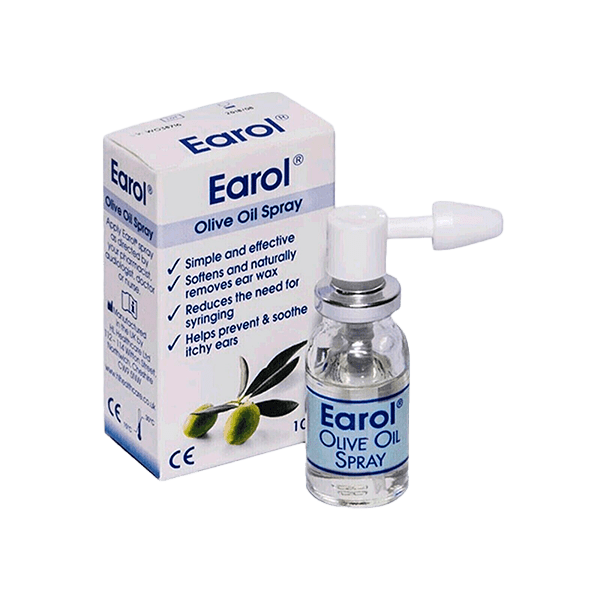
Common ear wax removal drops and sprays:
Olive oil ear drops
Olive oil is our top-pick for ear wax softeners. It works well for most cases so long as you apply it correctly and have the right expectations; you are softening your ear wax to prepare for your ear wax removal appointment.
Olive oil drops alone will most likely not improve your hearing; they lubricate the ear canal and soften your ear wax so it can be easily removed professionally. We recommend earol olive oil spray. It is important you apply this correctly so here’s some guidance on how to apply earol.
Hydrogen peroxide ear drops
Hydrogen peroxide ear drops are useful in cases of hard ear wax. Our advice is to get your ears examined first to ensure your wax is hard enough to warrant using these drops. Prolonged use can cause irritation to the ear canal. A popular brand is Otex.
Sodium Bicarbonate ear drops
Similarly, sodium bicarbonate ear drops are effective and can be used to break down hard ear wax before microsuction. Again, only your ear practitioner can advise whether your ear wax is hard enough to require this softening solution.
One downside to using sodium bicarbonate as a wax softener is that it is an Alkali hence able to neutralise acid. This is significant because ear wax secretions are acidic and fosters an environment in the ear canal that prevents fungal and bacterial ear infections from developing. Alkali counteracts acid so using these drops could leave you more susceptible to an ear infection.
Prolonged use can also excessively soften the ear wax making it difficult to remove using gold-standard procedures like microsuction. A popular brand is Otex.
Ear wax removal Methods
Ear wax removal can be a straightforward procedure when done correctly. Some ear wax removal procedures are discredited and should not be used in clinics because of the inherent risks. Our list of professional ear wax removal methods are evidence-based procedures we endorse due to its safety and the science behind it. Any procedure on the discredited ear wax removal list should be avoided for your safety.
Professional ear wax removal methods
Microsuction ear wax removal
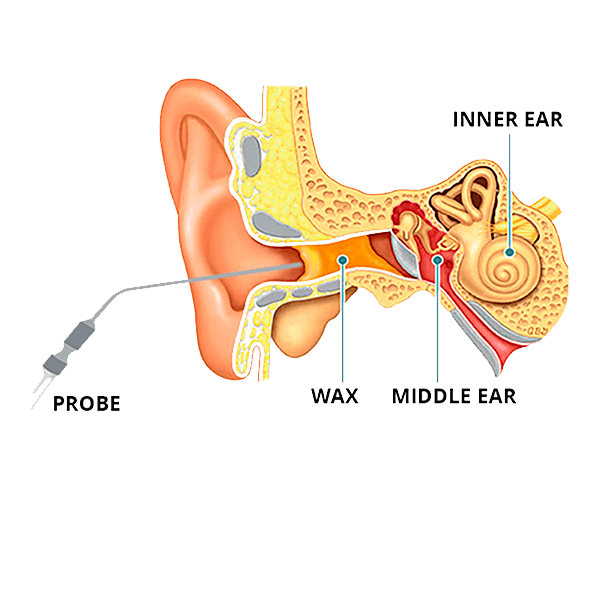
Microsuction ear wax removal is one of the quickest and safest ways to remove earwax blockage fast. The clinician uses a single-use probe connected to a suction machine to remove ear wax while viewing through a microscope to get a clear view of the ear canal during the procedure. This method is favoured for its speed, safety, and minimal risk of ear infection. Microsuction is often considered more comfortable and less messy than traditional methods like manual ear syringing, and it’s suitable for most individuals, including those with perforated eardrums or previous ear surgeries.
Camera ear wax removal (Also known as Endoscopic ear wax removal)
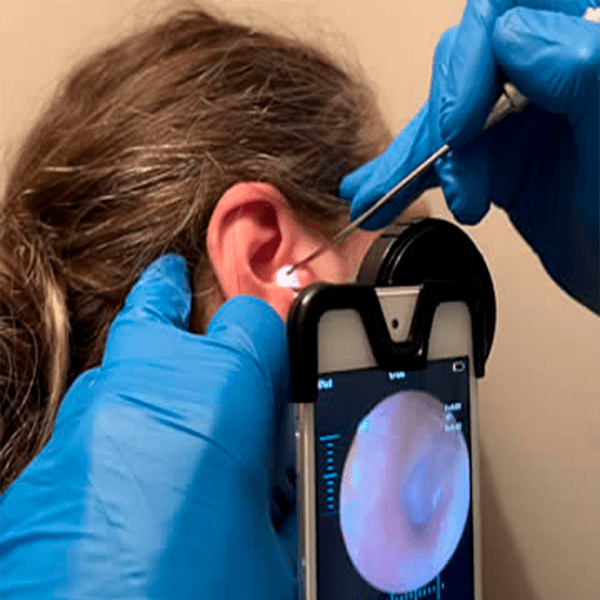
An oto-endoscope is a medical instrument that consists of a long, thin and rigid tube with a light source and a camera that can be used to visualise and examine the ear canal safely. For this type of ear wax removal, the procedure is similar to microsuction, except the clinician uses an oto-endoscope to visualise the ear canal during the procedure as opposed to a microscope. The advantages are that the clinician has a wider field of vision when using this technique and can show the patient images and videos of the procedure which from our experience a lot of patients love. Patients find endoscopic ear wax removal more comfortable than microsuction
Ear irrigation
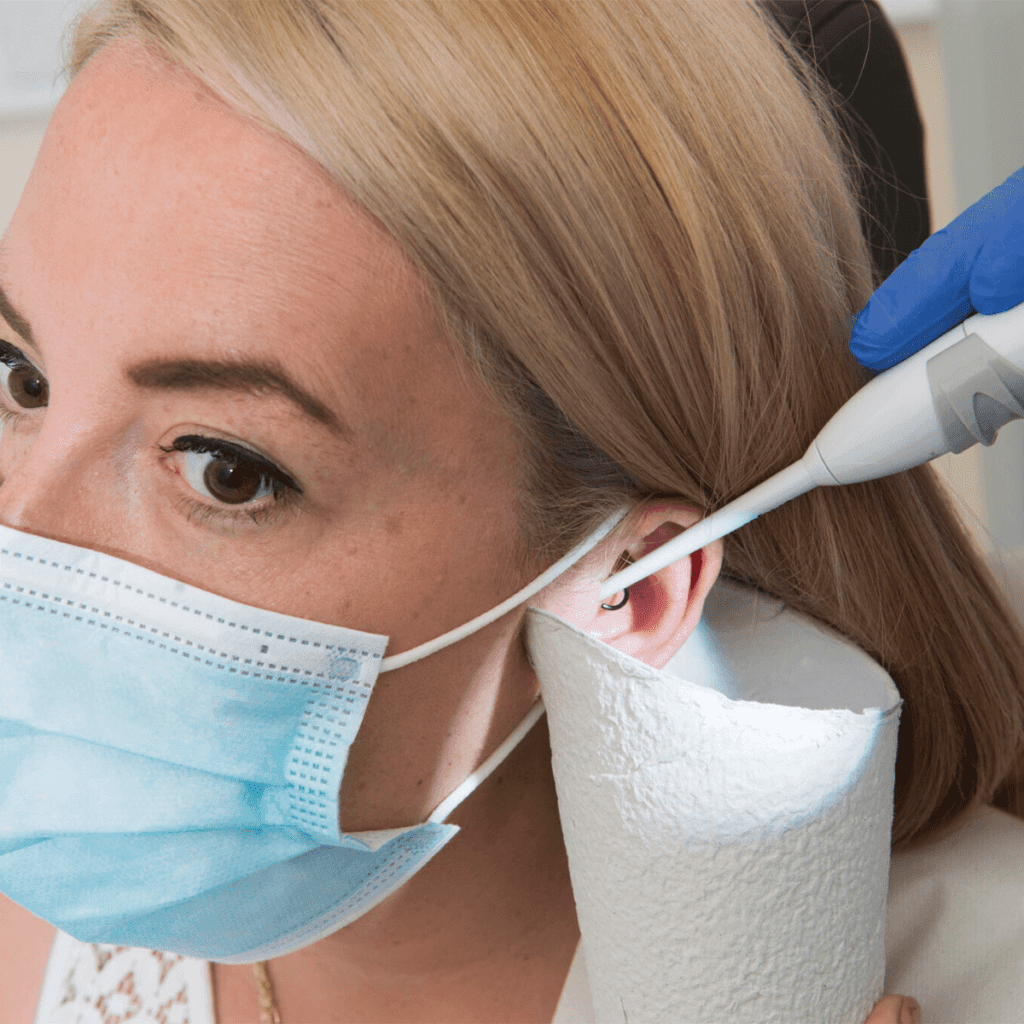
Image courtesy of ear wax clear
Ear irrigation is performed using an electrically-powered irrigation machine. The machine allows for a controlled flow of water. This controlled, gentle stream minimises the risk of damage to the delicate structures of the ear. The ear practitioner gently flushes the ear wax out of your ear canal using lukewarm water (at body temperature). Ear irrigation
Ear wax removal with Probes and Forceps
In some instances, we find it is safer to remove ear wax with ENT-grade specialist tools designed for ear cleaning such as a probe or forceps. This is useful in cases where patients are sensitive to noise or have tinnitus. Your clinician will be able to make the clinical judgement of the safety of this procedure for you based on a number of factors such as the position and the consistency of the ear wax.
Discredited ear wax removal methods
Ear candling
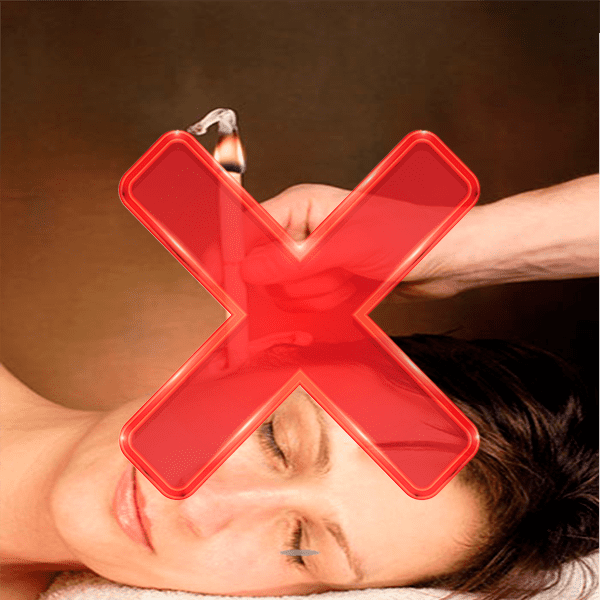
Ear candling, also known as ear coning, is an alternative therapy that involves placing a hollow, cone-shaped candle into the ear canal and then lighting the opposite end. The heat is believed by proponents to create a suction that draws out earwax and other impurities. However, scientific evidence does not support its efficacy, and it can pose risks, including burns, ear canal obstructions, and even perforated eardrums. We strongly advise against this discredited method of ear wax removal.
Manual Ear syringing
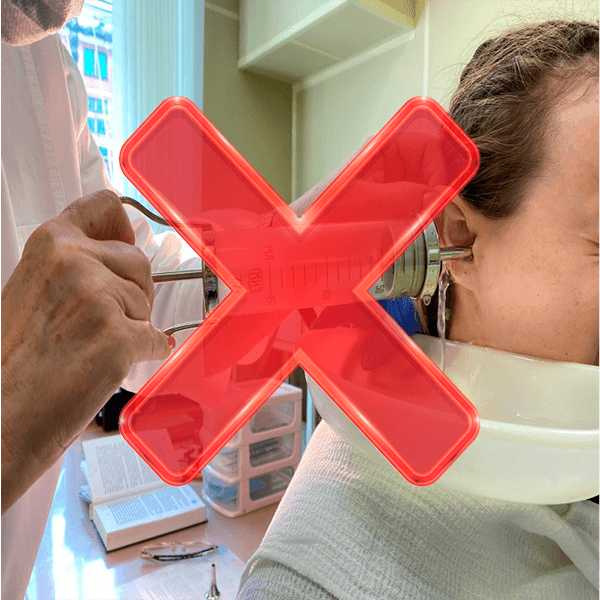
Manual ear syringing is a method used to remove earwax by injecting water or a saline solution into the ear canal with a bulb syringe. Ear syringing poses a greater risk of ear infections and holds potential for an ear drum perforation due to uncontrolled force of the water from the syringe. It also pushes the wax deeper into the ear canal in some cases and can cause dizziness. Due to these risks, ear syringing is increasingly viewed as a less preferred and potentially harmful method for earwax removal, and many professionals now opt for safer methods like microsuction.
Cleaning your ears at home
For your safety and to prevent potential ear damage, we advise against attempting to remove earwax at home. If you suspect a buildup or blockage, seek professional advice. If you do not have a perforation, you can use over-the-counter ear drops such as sodium bicarbonate ear drops or olive oil ear drops for 3-5 days to prepare for your ear wax removal appointment.
These drops rarely remove your ear wax or unblock your ears permanently. Their function is to soften the ear wax and lubricate your ear canal so your wax can be removed with ease using any of the professional ear wax removal methods. Do not panic if your hearing gets worse after using ear drops at home.
In most cases, this means the ear drops have softened the ear wax which has now expanded in your ear canal. The result of this is your ears feeling more blocked. If you have followed our ear drops guide, you would know how long to use your particular ear drops for. It is now time to see an ear wax removal specialist.

Use cotton swabs (like Q-tips) inside the ear canal. They can push the wax deeper, leading to impaction.
Insert any sharp or pointed objects into the ear.
Use ear candles. They have not been proven effective and can cause burns, wax blockage, or even perforate the eardrum.
Use warm water from a shower to wash your ears or use any ear syringing kits sold in pharmacies.
These things would most likely make your ears feel more blocked, impact the ear wax further and put you at risk of developing an ear infection.
Ear Wax Removal for Babies and Toddlers
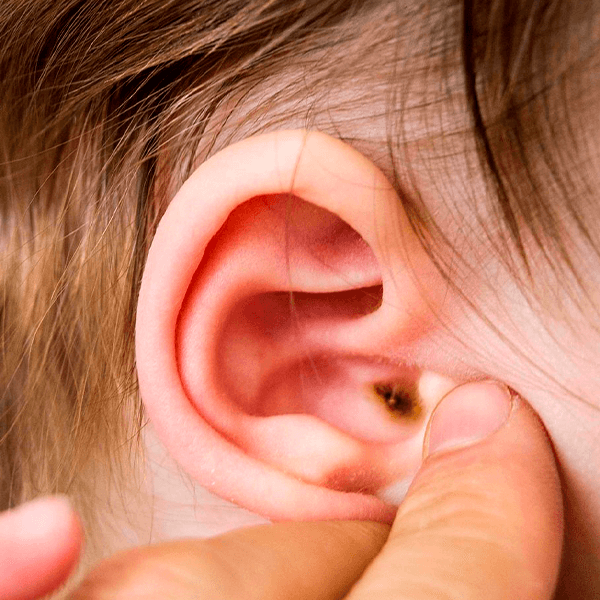
Children, especially babies and toddlers, have narrower ear canals than adults, making them more prone to ear wax blockages. Excessive ear wax can cause a temporary hearing loss in children as well as general ear discomfort.
Older toddlers can sometimes report if they feel their ears are blocked. For younger children and babies, you may notice the baby is fussier than usual, pulling at their ear, or showing changes in hearing or responsiveness.
In the UK, an Ear, nose and throat (ENT) doctor, Paediatric Audiologist, or specialist paediatric nurse could be qualified to remove your child’s ear wax. At Verified Hearing, our Paediatric Audiologists are highly trained to remove excessive ear wax from your child’s ears.
Professional Consultation: You can begin with a visit to your GP or book your child in to see us first. Children's ears are sensitive, and what might appear as a wax blockage could be an infection or an underlying issue like glue ear.
Use Ear Drops: It is very important you soften your child’s ear wax before their ear wax removal appointment. In children, there is usually a brief window of opportunity to take out their wax safely and we may miss this opportunity if the ear wax is too hard. Use olive oil ear drops for a minimum of 3-5 days before your appointment. Only use sodium bicarbonate or hydrogen peroxide drops if you have physically seen an ear professional who has confirmed your child’s ear wax is hard enough to warrant its use
Avoiding at-home ear cleaning: The ear canals of children are delicate. Cotton swabs can push wax deeper, causing impactions. They might also risk injuring the eardrum. Do not use any irrigation kit even if you can get these from the pharmacy.
Find out more about our children ear wax removal service here
Ear wax removal tools
Us Brits love a good DIY and of course it makes sense to extend this to ear wax removal. On the surface it seems like a simple, straightforward procedure – and it is if you are trained professionally. The problem is to successfully remove ear wax out of your ear canal with a tool at home, you need to understand the anatomy of the ear so you ensure you only clean the parts of the ear canal that are safe to.
For instance, during endoscopic ear wax removal, patients often ask if we would not clean the white spot on their ear drum. Now, that white spot is the handle of the malleus which is part of their normal anatomy and removing it would mean severely damaging their ear and hearing so of course we say no. How would you know this if you were cleaning your ears at home? This is why we strongly advise against using ear wax removal tools at home with or without a camera.
Ear wax removal price
We charge £85 for one or both ears. This charge is for the appointment time. If you are not sure if you have wax in your ears but feel your ears are blocked, you can book a free ear check.
Where to get ear wax removal in the UK
NHS ear wax removal:
It is rare to come across an NHS GP practice that offers ear wax removal. Most GP practices have stopped offering this service and either advise you to go privately or refer you to your local ENT department. You can always check to see if your local GP practice offers ear wax removal. If you are unable to access the service at your GP, we would be happy to see you privately
Private ear wax removal:
Most people remove their ear wax privately in the UK. Private ear wax removal is quick and in some cases your local clinic may have same-day availability. Some private clinics also have a mobile ear wax removal service if you are unable to come into the clinic. There are lots of ear wax removal clinics to choose from but our advice would be to make sure that team has the right qualifications. In most cases, you are safer going with an Audiologist, ENT doctor, or Specialist nurse. Although other professionals such as Pharmacists may offer this service, their theoretical and practical knowledge of the ear and hearing related issues may be limited. We staff our ear wax removal clinic in London with Audiologists and specialist nurses only.
Blocked ears? Don’t suffer in silence.

